Experimental Evaluation of Noise Exposure Effects on Subjective Perceptions and Cognitive Performance
Abstract
:1. Introduction
1.1. Noise Exposure and Human Health
1.2. Noise Exposure and Human Cognitive Performance
1.3. Research Motivation and Objectives
2. Materials and Methods
2.1. Study Design
2.2. Subjects
2.3. Materials and Stimuli
2.3.1. Noise Exposure Conditions
2.3.2. Perceived Sound Quality
2.3.3. Human Emotions
2.3.4. Cognitive Performance
- (1)
- Perception (auditory tests)
- (2)
- Attention (psychomotor vigilance task)
- (3)
- Working memory (2-back test)
- (4)
- Mental arithmetic (mental arithmetic test)
- (5)
- Executive function (Stroop test)
2.4. Experimental Procedure
2.5. Statistical Analysis
3. Results
3.1. Noise Exposure Effect on Perceived Sound Quality
- (1)
- As shown in Figure 4a, the main effect of noise suggested that decreased intensity had a positive effect on reducing subjective dissatisfaction. The main effect of TP suggested that adaption to noisy environments could weaken a subject’s dissatisfaction. The noise × TP interaction effect was observed, reflecting that longer exposure times can exacerbate and even change the effect of noise on a subject’s dissatisfaction. For example, the declined noise level from 85 dBA to 80 dBA had a greater improvement on human dissatisfaction at TP5 compared to TP1 (p = 0.085) and TP3 (p = 0.053). In addition, N80-S1 was rated as more dissatisfying than N75-S2 at the beginning of exposure (TP1), which was mediated by exposure time at TP4 (p = 0.055) and TP5 (p = 0.019), reflecting that the higher sharpness was more likely to cause dissatisfaction when subjects were exposed for a long time.
- (2)
- As shown in Figure 4b, compared to the dissatisfaction, the subject’s annoyance was more sensitive to changes in noise condition. Specifically, the main effect of noise suggested that a lower noise level was rated as less annoying, and the main effect of TP indicated that the subjective annoyance caused by noise was aggravated by the increase in exposure time. In addition, exposure time was observed as moderating the effect of noise on a subject’s annoyance. For example, the decline in annoyance from N85-S1 and N80-S1 to N75-S2 at TP2 (p = 0.010, p = 0.028), and from N85-S1 to N80-S1 at TP4 (p = 0.046) and TP5 (p = 0.046), was smaller than that at TP1.
- (3)
- The effectiveness of the designed noise stimulus could be verified according to the results in Figure 4c–e. As shown in Figure 4c, the subjects were clearly aware of the change in noise intensity of 5 dBA (85 dBA vs. 80 dBA), which was in accordance with expectation. But the changed sharpness of noise affected the perception of noise loudness (80 dBA vs. 75 dBA with higher sharpness). The main effect of TP suggested that adaption to noise loudness occurred with increasing exposure times. As shown in Figure 4d,e, the main effect of noise on a subject’s perceived sharpness, with no obvious effect on perceived roughness, proved the effectiveness of the designed noise stimulus. The main effect of TP was not significant on perceived sharpness. No interaction effects were found. So, it can be inferred that the perceived sharpness of noise was not easily affected by exposure time nor by noise intensity.
3.2. Noise Exposure Effect on Emotions
3.3. Noise Exposure Effect on Cognitive Performance
- (1)
- Working memory and mental arithmetic
- (2)
- Hearing perception
- (3)
- Attention
- (4)
- Executive function
3.4. Correlation Analyses
- (1)
- The subject’s perceived sound quality (dissatisfaction and annoyance) and negative emotions can be considered as significantly correlated, but are not related to positive emotions.
- (2)
- Cognitive abilities are not independent, and can be considered as significantly correlated with human emotions. For example, dissatisfaction with noise and negative affects had inverse correlations with the performance metrics of several tests, which may be because the subjects tried to finish the tasks quickly at the expense of accuracy when their dissatisfaction or negative emotions increased. The lower ratings on noise annoyance were moderately correlated with an impaired ability to distinguish the frequency differences of sound stimuli. Positive affects were positively correlated with reaction speed in the Stoop test.
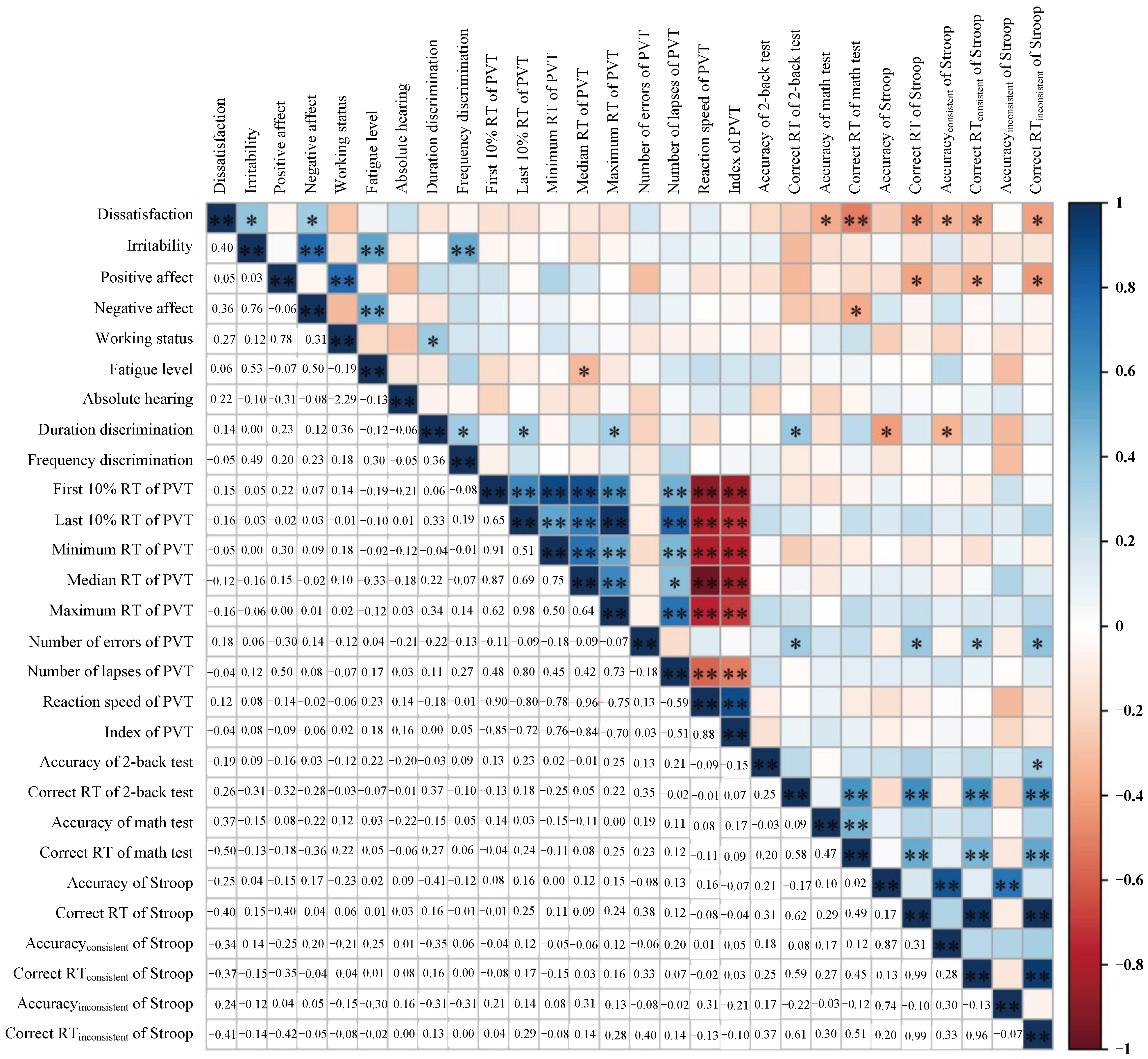
4. Discussion
4.1. Comparison with Previous Studies
4.2. Underlying Mechanism Analysis Based on PLS-SEM
- (1)
- The poorer sound quality directly resulted in an increase in the hearing threshold and frequency discrimination threshold. These effects, however, had no further impact on the performance of visual tasks (such as the PVT test, 2-back test, and Stroop test, in this study), which may be due to the different perception channels required for various cognitive tests.
- (2)
- The subject’s positive and negative emotions were directly impacted by noise exposure, which further affected the subject’s cognitive performance with different effect paths. The effect of noise on cognitive performance may be transferred to information processing and, ultimately, to executive function.
- (3)
- Overall, these findings may imply a potential underlying mechanism of the effect of noise on cognitive performance, indicating that negative feelings towards noise contribute to poor emotional states, subsequently influencing cognitive processes and impairing executive function.
4.3. Limitations
5. Conclusions
- (1)
- Reduction in noise SPL is beneficial in diminishing subject dissatisfaction, annoyance, and false alerts, while concurrently enhancing positive emotions, improving auditory perception and discrimination abilities, and accelerating execution speed. Importantly, these effects are largely counteracted by poor sound quality, characterized by increased noise sharpness.
- (2)
- Subjective annoyance exhibits greater sensitivity to changes in noise conditions compared to dissatisfaction, and this intensifies with prolonged exposure.
- (3)
- Significant correlations were observed between human emotions and cognitive abilities, with emotions serving as mediators between noise exposure and cognitive performance. The underlying mechanism suggests that unfavorable feelings towards noise contribute to diminished emotional states, subsequently influencing cognitive processes and impairing executive function.
Author Contributions
Funding
Data Availability Statement
Acknowledgments
Conflicts of Interest
Appendix A
| Condition | Dissatisfaction | Annoying | Perceived Loudness | Perceived Sharpness | Perceived Roughness | |||||
|---|---|---|---|---|---|---|---|---|---|---|
| Estimate | p-Value | Estimate | p-Value | Estimate | p-Value | Estimate | p-Value | Estimate | p-Value | |
| (N85-S1,TP1) | 4.083 | — | 3.333 | — | 4.583 | — | 2.250 | — | 3.417 | — |
| N80-S1 | −0.250 | 0.360 | −1.167 ** | <0.001 | −1.583 ** | <0.001 | −0.500 | 0.062 | −0.667 | 0.114 |
| N75-S2 | −0.917 ** | 0.001 | −0.917 ** | 0.002 | −1.333 ** | <0.001 | 1.167 ** | <0.001 | −0.250 | 0.552 |
| TP2 | −0.250 | 0.360 | −0.833 ** | 0.005 | −0.500 | 0.098 | 0.000 | 1.000 | 0.000 | 1.000 |
| TP3 | −0.167 | 0.541 | −0.333 | 0.257 | −0.667 * | 0.028 | −0.083 | 0.754 | 0.000 | 1.000 |
| TP4 | −0.167 | 0.541 | −0.833 | 0.776 | −0.500 | 0.098 | 0.000 | 1.000 | −0.167 | 0.692 |
| TP5 | 0.000 | 1.000 | −0.833 | 0.776 | −0.333 | 0.268 | 0.083 | 0.754 | 0.000 | 1.000 |
| N80-S1:TP2 | −0.083 | 0.829 | 0.917 * | 0.028 | 0.083 | 0.845 | 0.167 | 0.658 | −0.083 | 0.889 |
| N75-S2:TP2 | 0.500 | 0.196 | 1.083 * | 0.010 | 0.417 | 0.327 | −0.083 | 0.825 | 0.167 | 0.779 |
| N80-S1:TP3 | 0.083 | 0.829 | 0.500 | 0.229 | 0.333 | 0.433 | 0.500 | 0.185 | 0.000 | 1.000 |
| N75-S2:TP3 | 0.594 | 0.129 | 0.600 | 0.154 | 0.590 | 0.171 | 0.071 | 0.852 | 0.060 | 0.921 |
| N80-S1:TP4 | −0.250 | 0.517 | 0.833 * | 0.046 | 0.583 | 0.171 | 0.167 | 0.658 | 0.417 | 0.484 |
| N75-S2:TP4 | 0.667 | 0.085 | 0.500 | 0.229 | 0.500 | 0.240 | 0.417 | 0.269 | 0.667 | 0.263 |
| N80-S1:TP5 | −0.667 | 0.085 | 0.833 * | 0.046 | 0.417 | 0.327 | 0.167 | 0.658 | 0.333 | 0.575 |
| N75-S2:TP5 | 0.417 | 0.281 | 0.250 | 0.547 | 0.500 | 0.240 | 0.083 | 0.825 | 0.333 | 0.575 |
| Tests | Metrics | Condition | Estimate | p-Value | Condition | Estimate | p-Value |
|---|---|---|---|---|---|---|---|
| PANAS scale | Positive affect | Intercept | 21.167 | — | Intercept | 23.750 | — |
| N85-S1 | Reference | N85-S1 | −2.583 | 0.131 | |||
| N80-S1 | 2.583 | 0.131 | N80-S1 | Reference | |||
| N75-S2 | 5.083 ** | 0.005 | N75-S2 | 2.500 | 0.143 | ||
| Negative affect | Intercept | 15.500 | — | Intercept | 14.333 | — | |
| N85-S1 | Reference | N85-S1 | 1.167 | 0.345 | |||
| N80-S1 | −1.167 | 0.345 | N80-S1 | Reference | |||
| N75-S2 | −1.167 | 0.345 | N75-S2 | 0.000 | 1.000 | ||
| Tests | Metrics | Condition | Estimate | p-Value | Condition | Estimate | p-Value |
|---|---|---|---|---|---|---|---|
| Auditory tests | Absolute threshold of hearing | Intercept | −26.645 | — | Intercept | −32.058 | — |
| N85-S1 | Reference | N85-S1 | 5.412 ** | 0.008 | |||
| N80-S1 | −5.412 ** | 0.008 | N80-S1 | Reference | |||
| N75-S2 | −35.296 ** | <0.001 | N75-S2 | −29.883 ** | <0.001 | ||
| Duration discrimination threshold | Intercept | 319.479 | — | Intercept | 311.612 | — | |
| N85-S1 | Reference | N85-S1 | 7.867 | 0.069 | |||
| N80-S1 | −7.867 | 0.069 | N80-S1 | Reference | |||
| N75-S2 | −12.200 ** | 0.007 | N75-S2 | −4.333 | 0.304 | ||
| Frequency discrimination threshold | Intercept | 1014.648 | — | Intercept | 1006.266 | — | |
| N85-S1 | Reference | N85-S1 | 8.382 * | 0.036 | |||
| N80-S1 | −8.382 * | 0.036 | N80-S1 | Reference | |||
| N75-S2 | −8.383 * | 0.036 | N75-S2 | −0.001 | 1.000 | ||
| 2-back | Accuracy | Intercept | 0.985 | — | Intercept | 0.979 | — |
| N85-S1 | Reference | N85-S1 | 0.006 | 0.385 | |||
| N80-S1 | −0.006 | 0.385 | N80-S1 | Reference | |||
| N75-S2 | 0.006 | 0.385 | N75-S2 | 0.013 | 0.090 | ||
| Correct RT | Intercept | 861.813 | — | Intercept | 881.982 | — | |
| N85-S1 | Reference | N85-S1 | −20.169 | 0.588 | |||
| N80-S1 | 20.169 | 0.588 | N80-S1 | Reference | |||
| N75-S2 | −0.455 | 0.990 | N75-S2 | −20.624 | 0.579 | ||
| PVT | First 10% RT | Intercept | 274.173 | — | Intercept | 265.217 | — |
| N85-S1 | Reference | N85-S1 | 8.956 | 0.223 | |||
| N80-S1 | −8.956 | 0.223 | N80-S1 | Reference | |||
| N75-S2 | 9.998 | 0.175 | N75-S2 | 18.954 * | 0.015 | ||
| Last 10% RT | Intercept | 451.660 | — | Intercept | 416.083 | — | |
| N85-S1 | Reference | N85-S1 | 35.576 | 0.092 | |||
| N80-S1 | −35.576 | 0.092 | N80-S1 | Reference | |||
| N75-S2 | −20.106 | 0.330 | N75-S2 | 15.471 | 0.451 | ||
| Minimum RT | Intercept | 263.417 | — | Intercept | 254.833 | — | |
| N85-S1 | Reference | N85-S1 | 8.583 | 0.202 | |||
| N80-S1 | −8.583 | 0.202 | N80-S1 | Reference | |||
| N75-S2 | 7.250 | 0.279 | N75-S2 | 15.833 * | 0.024 | ||
| Median RT | Intercept | 316.667 | — | Intercept | 308.375 | — | |
| N85-S1 | Reference | N85-S1 | 8.292 | 0.276 | |||
| N80-S1 | −8.292 | 0.276 | N80-S1 | Reference | |||
| N75-S2 | 10.208 | 0.183 | N75-S2 | 18.500 * | 0.021 | ||
| Maximum RT | Intercept | 474.750 | — | Intercept | 444.417 | — | |
| N85-S1 | Reference | N85-S1 | 30.333 | 0.194 | |||
| N80-S1 | −30.333 | 0.194 | N80-S1 | Reference | |||
| N75-S2 | −20.833 | 0.368 | N75-S2 | 9.500 | 0.679 | ||
| Number of errors | Intercept | 0.583 | — | Intercept | 0.333 | — | |
| N85-S1 | Reference | N85-S1 | 0.250 | 0.356 | |||
| N80-S1 | −0.250 | 0.356 | N80-S1 | Reference | |||
| N75-S2 | 0.083 | 0.756 | N75-S2 | 0.333 | 0.222 | ||
| Number of lapses | Intercept | 1.083 | — | Intercept | 0.167 | — | |
| N85-S1 | Reference | N85-S1 | 0.917 * | 0.016 | |||
| N80-S1 | −0.917 * | 0.016 | N80-S1 | Reference | |||
| N75-S2 | −0.583 | 0.110 | N75-S2 | 0.333 | 0.351 | ||
| Reaction speed | Intercept | 3.067 | — | Intercept | 3.164 | — | |
| N85-S1 | Reference | N85-S1 | −0.097 | 0.257 | |||
| N80-S1 | 0.097 | 0.257 | N80-S1 | Reference | |||
| N75-S2 | −0.080 | 0.348 | N75-S2 | −0.177 * | 0.045 | ||
| Index of PVT | Intercept | 135.167 | — | Intercept | 142.391 | — | |
| N85-S1 | Reference | N85-S1 | −7.223 | 0.123 | |||
| N80-S1 | 7.223 | 0.123 | N80-S1 | Reference | |||
| N75-S2 | −5.190 | 0.261 | N75-S2 | −12.413 * | 0.012 | ||
| Math calculation | Accuracy | Intercept | 0.936 | — | Intercept | 0.942 | — |
| N85-S1 | Reference | N85-S1 | −0.006 | 0.758 | |||
| N80-S1 | 0.006 | 0.758 | N80-S1 | Reference | |||
| N75-S2 | 0.014 | 0.443 | N75-S2 | 0.008 | 0.644 | ||
| Correct RT | Intercept | 4583.681 | — | Intercept | 4433.043 | — | |
| N85-S1 | Reference | N85-S1 | 150.638 | 0.421 | |||
| N80-S1 | −150.638 | 0.421 | N80-S1 | Reference | |||
| N75-S2 | −231.408 | 0.221 | N75-S2 | −80.770 | 0.664 | ||
| Stroop | Accuracy | Intercept | 0.956 | — | Intercept | 0.969 | — |
| N85-S1 | Reference | N85-S1 | −0.013 | 0.118 | |||
| N80-S1 | 0.013 | 0.118 | N80-S1 | Reference | |||
| N75-S2 | 0.005 | 0.505 | N75-S2 | −0.007 | 0.353 | ||
| Correct RT | Intercept | 391.000 | — | Intercept | 373.721 | — | |
| N85-S1 | Reference | N85-S1 | 17.278 * | 0.047 | |||
| N80-S1 | −17.278 * | 0.047 | N80-S1 | Reference | |||
| N75-S2 | −14.506 | 0.091 | N75-S2 | 2.772 | 0.739 | ||
| Accuracy for consistent | Intercept | 0.963 | — | Intercept | 0.973 | — | |
| N85-S1 | Reference | N85-S1 | −0.010 | 0.425 | |||
| N80-S1 | 0.010 | 0.425 | N80-S1 | Reference | |||
| N75-S2 | 0.000 | 1.000 | N75-S2 | −0.010 | 0.425 | ||
| Correct RT for consistent | Intercept | 391.295 | — | Intercept | 374.726 | — | |
| N85-S1 | Reference | N85-S1 | 16.570 | 0.097 | |||
| N80-S1 | −16.570 | 0.097 | N80-S1 | Reference | |||
| N75-S2 | −17.595 | 0.080 | N75-S2 | −1.025 | 0.916 | ||
| Accuracy for inconsistent | Intercept | 0.950 | — | Intercept | 0.965 | — | |
| N85-S1 | Reference | N85-S1 | −0.015 | 0.195 | |||
| N80-S1 | 0.015 | 0.195 | N80-S1 | Reference | |||
| N75-S2 | 0.010 | 0.350 | N75-S2 | −0.004 | 0.706 | ||
| Correct RT for inconsistent | Intercept | 393.501 | — | Intercept | 374.080 | — | |
| N85-S1 | Reference | N85-S1 | 19.422 * | 0.033 | |||
| N80-S1 | −19.422 * | 0.033 | N80-S1 | Reference | |||
| N75-S2 | −13.633 | 0.124 | N75-S2 | 5.788 | 0.504 | ||
References
- Hahad, O.; Kuntic, M.; Al-Kindi, S.; Kuntic, I.; Gilan, D.; Petrowski, K.; Daiber, A.; Münzel, T. Noise and mental health: Evidence, mechanisms, and consequences. J. Expo. Sci. Environ. Epidemiol. 2024. [Google Scholar] [CrossRef] [PubMed]
- Jafari, Z.; Kolb, B.E.; Mohajerani, M.H. Chronic traffic noise stress accelerates brain impairment and cognitive decline in mice. Exp. Neurol. 2018, 308, 1–12. [Google Scholar] [CrossRef] [PubMed]
- Cheng, Y.; Wang, X.; Yu, Y.; Gu, J.; Zhao, M.; Fu, Q.; Song, Y.L.; Liu, Y. Noise induced depression-like behavior, neuroinflammation and synaptic plasticity impairments: The protective effects of luteolin. Neurochem. Res. 2022, 47, 3318–3330. [Google Scholar] [CrossRef] [PubMed]
- Hahad, O.; Bayo Jimenez, M.T.; Kuntic, M.; Frenis, K.; Steven, S.; Daiber, A.; Muenzel, T. Cerebral consequences of environmental noise exposure. Environ. Int. 2022, 165, 107306. [Google Scholar] [CrossRef] [PubMed]
- Molesworth, B.R.C.; Burgess, M. Improving intelligibility at a safety critical point: In flight cabin safety. Saf. Sci. 2013, 51, 11–16. [Google Scholar] [CrossRef]
- Molesworth, B.R.C.; Burgess, M.; Wilcock, C. Comparison of the effects on memory tasks of babble and broadband noise. Acoust. Aust. 2018, 64, 205–214. [Google Scholar] [CrossRef]
- Herweg, N.A.; Bunzeck, N. Differential effects of white noise in cognitive and perceptual tasks. Front. Psychol. 2015, 6, 1639. [Google Scholar] [CrossRef] [PubMed]
- World Health Organization. Burden of Disease from Environmental Noise: Quantification of Healthy Life Years Lost in Europe; World Health Organization: Geneva, Switzerland, 2011. [Google Scholar]
- European Environment Agency. Noise; European Environment Agency: Copenhagen, Denmark, 2023. [Google Scholar]
- Lo Castro, F.; Iarossi, S.; Brambilla, G.; Mariconte, R.; Diano, M.; Bruzzaniti, V.; Strigari, L.; Raffaele, G.; Giliberti, C. Surveys on Noise in Some Hospital Wards and Self-Reported Reactions from Staff: A Case Study. Buildings 2022, 12, 2077. [Google Scholar] [CrossRef]
- Casla-Herguedas, B.; Romero-Fernández, A.; Carrascal, T.; Navas-Martín, M.A.; Cuerdo-Vilches, T. Noise Perception and Health Effects on Population: A Cross-Sectional Study on COVID-19 Lockdown by Noise Sources for Spanish Dwellings. Buildings 2023, 13, 2224. [Google Scholar] [CrossRef]
- Zajamsek, B.; Hansen, K.L.; Nguyen, P.D.; Lechat, B.; Micic, G.; Catcheside, P. Acceptability of amplitude modulated tonal wind farm noise for sleep: A laboratory study. Appl. Acoust. 2023, 205, 109234. [Google Scholar] [CrossRef]
- Okimiji, O.P.; Okafor, A.T.; Fasona, M.I.; Atoro, T.; Aborisade, M.A.; Simon, J.N. Proliferation of noise pollution: Implication on health and community perception in coastal slums. Appl. Acoust. 2023, 214, 109713. [Google Scholar] [CrossRef]
- Prell, C.G.; Hackett, T.A.; Ramachandran, R. Noise-induced hearing loss and its prevention: Current issues in mammalian hearing. Curr. Opin. Physiol. 2020, 18, 32–36. [Google Scholar] [CrossRef] [PubMed]
- Nathanson, J.A.; Berg, R.E.; Beeson, R. Noise Pollution. Britannica—Animals & Nature, 22 February 2024. [Google Scholar]
- Manohar, S.; Adler, H.J.; Radziwon, K.; Salvi, R. Interaction of Auditory and Pain Pathways: Effects of Stimulus Intensity, Hearing Loss and Opioid Signaling. Hear. Res. 2020, 393, 108012. [Google Scholar] [CrossRef] [PubMed]
- Hahad, O.; Prochaska, J.H.; Daiber, A.; Muenzel, T. Environmental noise-induced effects on stress hormones, oxidative stress, and vascular dysfunction: Key factors in the relationship between cerebrocardiovascular and psychological disorders. Oxid. Med. Cell. Longev. 2019, 2019, 4623109. [Google Scholar] [CrossRef] [PubMed]
- Monteiro, R.; Tomé, D.; Neves, P.; Silva, D.; Rodrigues, M.A. The interactive effect of occupational noise on attention and short-term memory: A pilot study. Noise Health 2018, 20, 190–198. [Google Scholar] [PubMed]
- Kostallari, K.; Parizet, E.; Chevret, P.; Amato, J.; Galy, E. Irrelevant speech effect in open plan offices: Comparison of two models explaining the decrease in performance by speech intelligibility and attempt to reduce inter individual differences of the mental workload by task customization. Appl. Acoust. 2020, 161, 107180. [Google Scholar] [CrossRef]
- Schlittmeier, S.J.; Weißgerber, T.; Kerber, S.; Fastl, H.; Hellbrück, J. Algorithmic modeling of the irrelevant sound effect (ISE) by the hearing sensation fluctuation strength. Atten. Percept. Psychophys. 2012, 74, 194–203. [Google Scholar] [CrossRef] [PubMed]
- Maria, K.; Kirstin, B.; Thomas, L. Does noise affect learning? A short review on noise effects on cognitive performance in children. Front. Psychol. 2013, 4, 578. [Google Scholar]
- Reinten, J.; Braat-Eggen, P.E.; Hornikx, M.; Kort, H.S.; Kohlrausch, A. The indoor sound environment and human task performance: A literature review on the role of room acoustics. Build. Environ. 2017, 123, 315–332. [Google Scholar] [CrossRef]
- Dipayan, D. A Systematic Review of the Effects of Noise Characteristics on Human Mental Performance. In Proceedings of the International Conference of the Indian Society of Ergonomics, Aligarh, India, 8–10 December 2021; pp. 1705–1717. [Google Scholar]
- Molesworth, B.R.C.; Burgess, M.; Zhou, A. The effects of noise on key workplace skills. J. Acoust. Soc. Am. 2015, 138, 2054–2061. [Google Scholar] [CrossRef]
- Molesworth, B.R.C.; Burgess, M.; Koh, S. The relationship between noise and mode of delivery on recognition memory and working memory. Appl. Acoust. 2017, 116, 329–336. [Google Scholar] [CrossRef]
- Schlittmeier, S.J.; Hellbrück, J.; Thaden, R.; Vorländer, M. The impact of background speech varying in intelligibility: Effects on cognitive performance and perceived disturbance. Ergonomics 2008, 51, 719–736. [Google Scholar] [CrossRef] [PubMed]
- Yang, C.Y.; Pang, L.P.; Liang, J.; Cao, X.D.; Fan, Y.R.; Zhang, J. Experimental Investigation of Task Performance and Human Vigilance in Different Noise Environments. Appl. Sci. 2022, 12, 11376. [Google Scholar] [CrossRef]
- Mohammad, J.J.; Reza, K.; Soheila, K.; Farough, M. The Effect of Noise Exposure on Cognitive Performance and Brain Activity Patterns. Open Access Maced. J. Med. Sci. 2019, 7, 2924–2931. [Google Scholar]
- Button, C.D.; Behm, G.D.; Holmes, M.; Mackinnon, N.S. Noise and muscle contraction affecting vigilance task performance. Occup. Ergon. 2004, 4, 157–171. [Google Scholar] [CrossRef]
- Irgens-Hansen, K.; Gundersen, H.; Sunde, E.; Baste, V.; Harris, A.; Bråtveit, M.; Moen, B.E. Noise exposure and cognitive performance: A study on personnel on board Royal Norwegian Navy vessels. Noise Health 2015, 17, 320–327. [Google Scholar] [CrossRef]
- Koelega, H.S.; Brinkman, J. Noise and vigilance: An evaluative review. Hum. Factors 1986, 28, 465–481. [Google Scholar] [CrossRef] [PubMed]
- Nassiri, P.; Monazam, M.; Dehaghi, B.F.; Ghavam, L.I.; Zakerian, S.A.; Azam, K. The effect of noise on human performance: A clinical trial. Int. J. Occup. Environ. Med. 2013, 4, 87–95. [Google Scholar] [PubMed]
- Ke, J.; Du, J.; Luo, X. The effect of noise content and level on cognitive performance measured by electroencephalography (EEG). Autom. Constr. 2021, 130, 103836. [Google Scholar] [CrossRef]
- Zalejska-Jonsson, A. Perceived Acoustic Quality and Effect on Occupants’ Satisfaction in Green and Conventional Residential Buildings. Buildings 2019, 9, 24. [Google Scholar] [CrossRef]
- Mohammadi, Z.; Jafari, M.J.; Khavanin, A.; Jafarpisheh, A.S.; Ameri, A.; Pouyakian, M. Dynamic EEG changes during exposure to noise at different levels of loudness and sharpness. Appl. Acoust. 2024, 216, 109739. [Google Scholar] [CrossRef]
- Yu, B.Y.; Wen, L.J.; Bai, J.; Chai, Y.Y. Effect of Road and Railway Sound on Psychological and Physiological Responses in an Office Environment. Buildings 2022, 12, 6. [Google Scholar] [CrossRef]
- Rostam, G.; Ebrahim, D. The Combined Effects of Occupational Exposure to Noise and Other Risk Factors—A Systematic Review. Noise Health 2019, 21, 125–141. [Google Scholar]
- Abbasi, A.M.; Darvishi, E.; Rodrigues, M.A.; Sayehmiri, K. Gender differences in cognitive performance and psychophysiological responses during noise exposure and different workloads. Appl. Acoust. 2022, 189, 108602. [Google Scholar] [CrossRef]
- Blauert, J. Product-sound design and assessment: An enigmatic issue from the point of view of engineering. In Proceedings of the INTER-NOISE and NOISE-CON Congress and Conference, Yokohama, Japan, 29–31 August 1994. [Google Scholar]
- Blauert, J.; Jekosch, U. Sound quality evaluation—A multilayered problem. Acta Acust. United Acust. 1997, 83, 747–753. [Google Scholar]
- Wang, Y.; Guo, H.; Yang, C. Objective Evaluation Model of Sound Quality. In Vehicle Interior Sound Quality; Springer: Singapore, 2023. [Google Scholar]
- Lan, L.; Lian, Z.W. Application of statistical power analysis-How to determine the right sample size in human health, comfort and productivity research. Build. Environ. 2010, 45, 1202–1213. [Google Scholar] [CrossRef]
- Fan, Y.R.; Liang, J.; Cao, X.D.; Pang, L.P.; Zhang, J. Effects of Noise Exposure and Mental Workload on Physiological Responses during Task Execution. Int. J. Environ. Res. Public Health 2022, 19, 12434. [Google Scholar] [CrossRef] [PubMed]
- ISO/FDIS 7933:2023; Ergonomics of the Thermal Environment—Analytical Determination and Interpretation of Heat Stress Using Calculation of the Predicted Heat Strain. ISO: Geneva, Switzerland, 2023.
- ANSI/ASHRAE 55-2010; Thermal Environmental Conditions for Human Occupancy. American Society of Heating, Refrigerating and Air-Conditioning Engineers (ANSI/ASHRAE): Peachtree Corners, GA, USA, 2010.
- Watson, D.; Clark, L.A.; Tellegen, A. Development and validation of brief measures of positive and negative affect: The PANAS scales. J. Personal. Soc. Psychol. 1988, 54, 1063–1070. [Google Scholar] [CrossRef] [PubMed]
- Pang, L.P.; Zhang, J.; Cao, X.D.; Wang, X.; Liang, J.; Zhang, L.; Guo, L. The effects of carbon dioxide exposure concentrations on human vigilance and sentiment in an enclosed workplace environment. Indoor Air 2021, 31, 467–479. [Google Scholar] [CrossRef]
- Cao, X.D.; Li, P.; Zhang, J.; Pang, L.P. Associations of human cognitive abilities with elevated carbon dioxide concentrations in an enclosed chamber. Atmosphere 2022, 13, 891. [Google Scholar] [CrossRef]
- Erdodi, L.A.; Sagar, S.; Seke, K.; Zuccato, B.G.; Schwartz, E.S.; Roth, R.M. The Stroop test as a measure of performance validity in adults clinically referred for neuropsychological assessment. Psychol. Assess. 2018, 30, 755–766. [Google Scholar] [CrossRef] [PubMed]
- Wittmann, M.; Leland, D.S.; Churan, J.; Paulus, M.P. Impaired time perception and motor timing in simulant-dependent subjects. Drug Alcohol Depend. 2007, 90, 183–192. [Google Scholar] [CrossRef] [PubMed]
- Thomann, J.; Baumann, C.R.; Landolt, H.P.; Werth, E. Psychomotor vigilance task demonstrates impaired vigilance in disorders with excessive daytime sleepiness. J. Clin. Sleep Med. 2014, 10, 1019–1024. [Google Scholar] [CrossRef] [PubMed]
- Jaeggi, S.M.; Studer-Luethi, B.; Buschkuehl, M.; Su, Y.F.; Jonides, J.; Perrig, W.J. The relationship between n-back performance and matrix reasoning—Implications for training and transfer. Intelligence 2010, 38, 625–635. [Google Scholar] [CrossRef]
- Gajewski, P.D.; Hanisch, E.; Falkenstein, M.; Thönes, S.; Wascher, E. What does the n-back task measure as we get older? Relations between working-memory and other cognitive functions across the lifespan. Front. Psychol. 2018, 9, 2208. [Google Scholar] [CrossRef] [PubMed]
- Tse, C.K.; Yu, K.C. The effects of visual cues, blindfold, synesthetic experience, and music training on pure-tone frequency discrimination. Behav. Sci. 2019, 9, 2. [Google Scholar] [CrossRef]
- Zhang, J.; Pang, L.P.; Cao, X.D.; Wanyan, X.R.; Wang, X.; Liang, J.; Zhang, L. The effects of elevated carbon dioxide concentration and mental workload on task performance in an enclosed environmental chamber. Build. Environ. 2020, 178, 106938. [Google Scholar] [CrossRef]
- Zhang, J.; Cao, X.D.; Wang, X.; Pang, L.P.; Liang, J.; Zhang, L. Physiological responses to elevated carbon dioxide concentration and mental workload during performing MATB tasks. Build. Environ. 2021, 195, 107752. [Google Scholar] [CrossRef]
- Choi, H.; Kim, H.; Hong, T.; An, J. Examining the indirect effects of indoor environmental quality on task performance: The mediating roles of physiological response and emotion. Build. Environ. 2023, 236, 110298. [Google Scholar] [CrossRef]
- Mir, M.; Nasirzadeh, F.; Lee, S.H.; Cabrera, D.; Mills, A. Construction noise management: A systematic review and directions for future research. Appl. Acoust. 2022, 197, 108936. [Google Scholar] [CrossRef]
- Nijs, L.; Saher, K.; den Ouden, D. Effect of room absorption on human vocal output in multitalker situations. J. Acoust. Soc. Am. 2008, 123, 803–813. [Google Scholar] [CrossRef] [PubMed]
- Hoskin, R.; Hunter, M.; Woodruff, P. Stress improves selective attention towards emotionally neutral left ear stimuli. Acta Psychol. 2014, 151, 214–221. [Google Scholar] [CrossRef] [PubMed]
- Enmarker, I. The effects of meaningful irrelevant speech and road traffic noise on teachers’ attention, episodic and semantic memory. Scand. J. Psychol. 2010, 45, 393–405. [Google Scholar] [CrossRef] [PubMed]
- Song, C.; Li, H.Q.D.; Ma, H.R.; Han, T.; Wu, J.P. Effects of Noise Type and Noise Sensitivity on Working Memory and Noise Annoyance. Noise Health 2022, 24, 173–181. [Google Scholar] [PubMed]
- Stansfeld, S.A.; Berglund, B.; Clark, C.; Lopez-Barrio, I.; Fischer, P.; Ohrström, E.; Haines, M.M.; Head, J.; Hygge, S.; van Kamp, I.; et al. Aircraft and road traffic noise and children’s cognition and health: A cross-national study. Lancet 2005, 365, 1942–1949. [Google Scholar] [CrossRef]
- Thompson, W.F.; Schellenberg, E.G. Husain arousal, mood, and the Mozart effect. Psychol. Sci. 2001, 12, 248–251. [Google Scholar] [CrossRef]
- Craig, A. Human engineering: The control of vigilance. In Sustained Attention in Human Performance; Warm, J.S., Ed.; Wiley: Chichester, UK, 1984. [Google Scholar]
- Molesworth, B.R.C. Contextual factors impacting on aviation communication. In Aviation English: A Lingua Franca for Pilots and Air Traffic Controllers; Estival, D., Farris, C., Molesworth, B.R.C., Eds.; Routledge: London, UK, 2016. [Google Scholar]
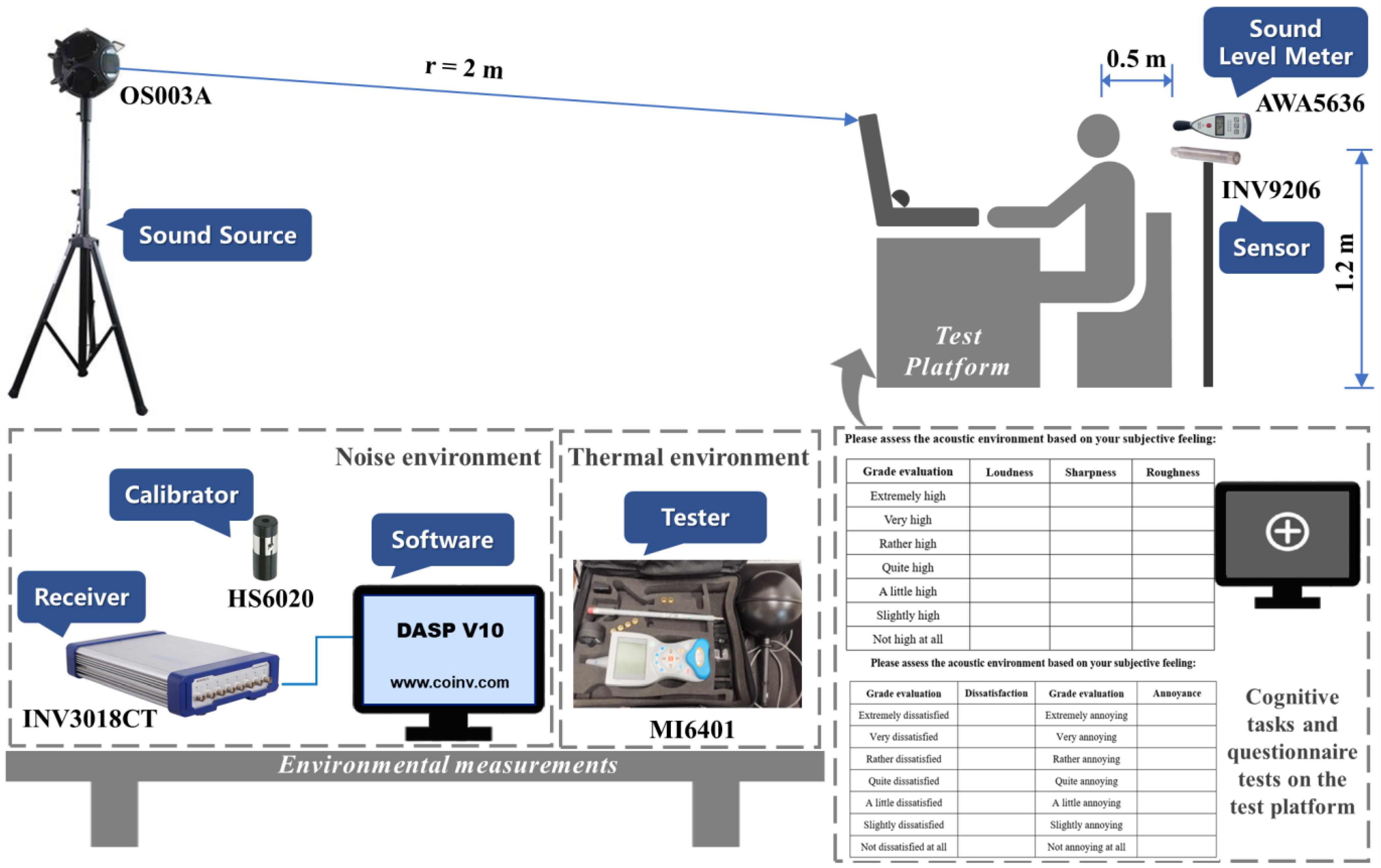

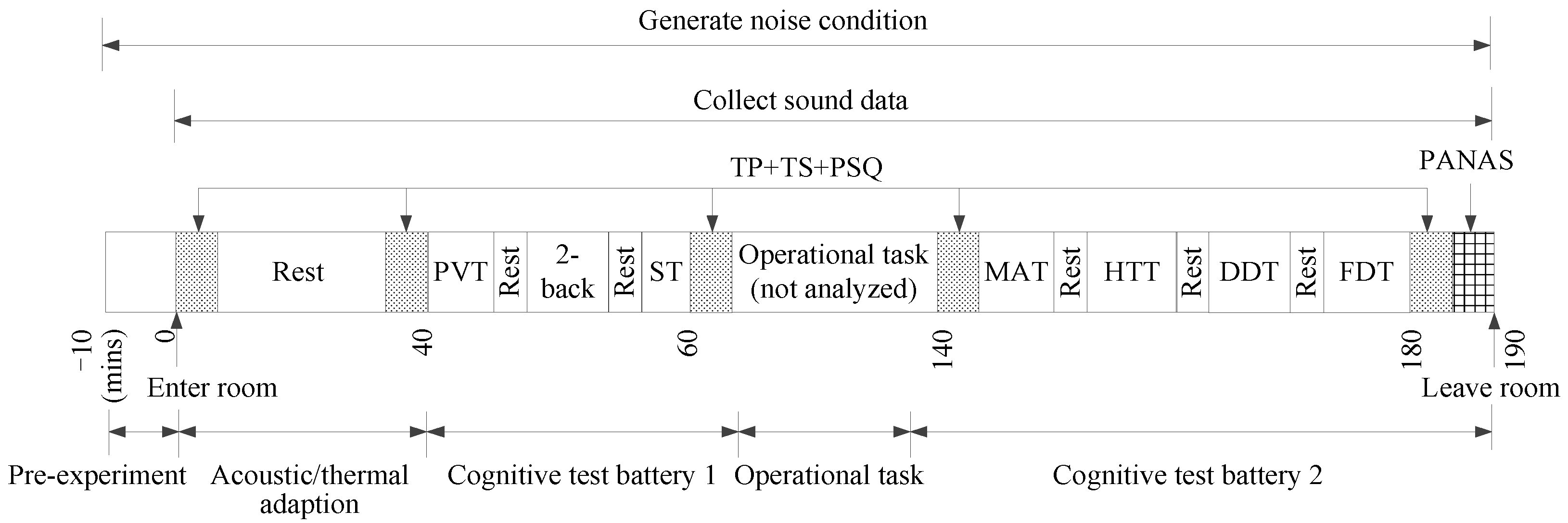

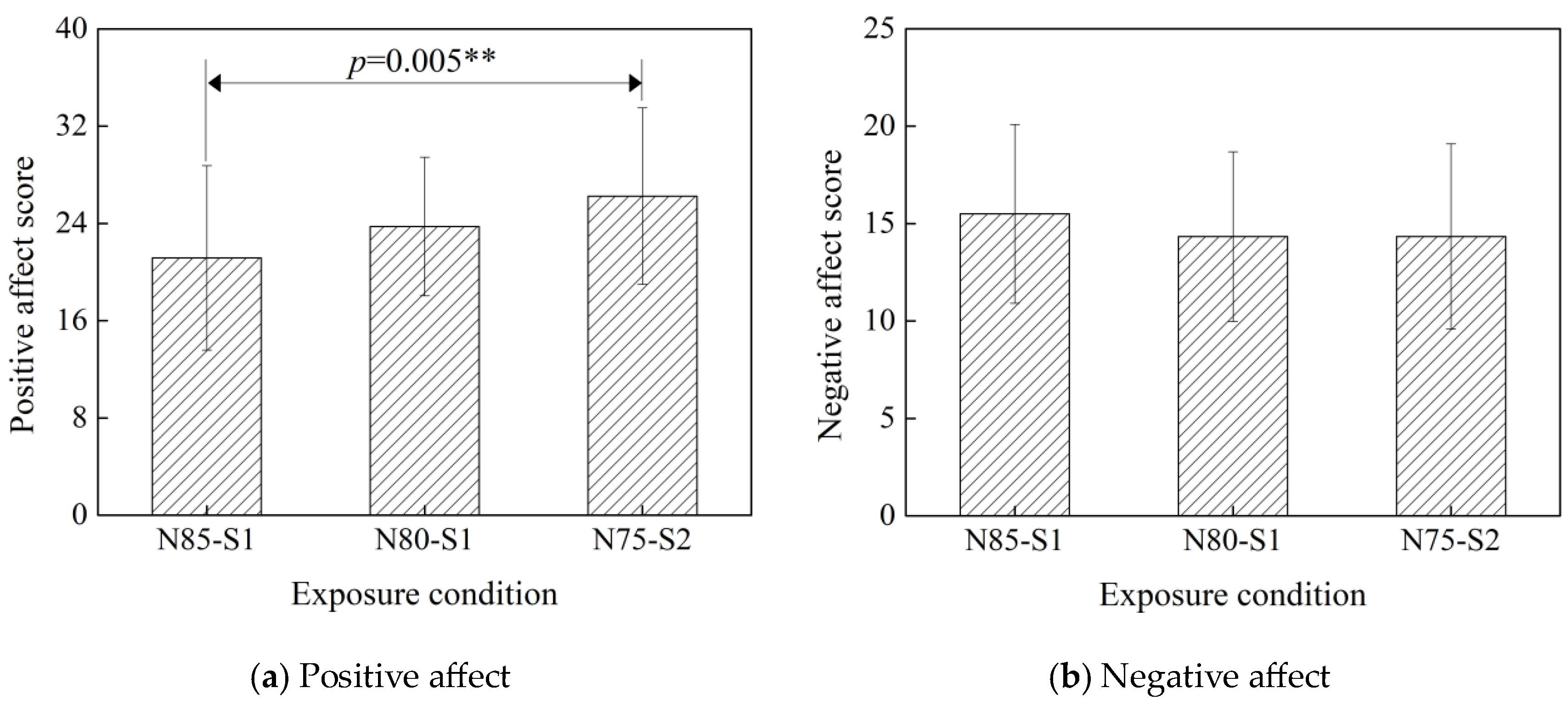
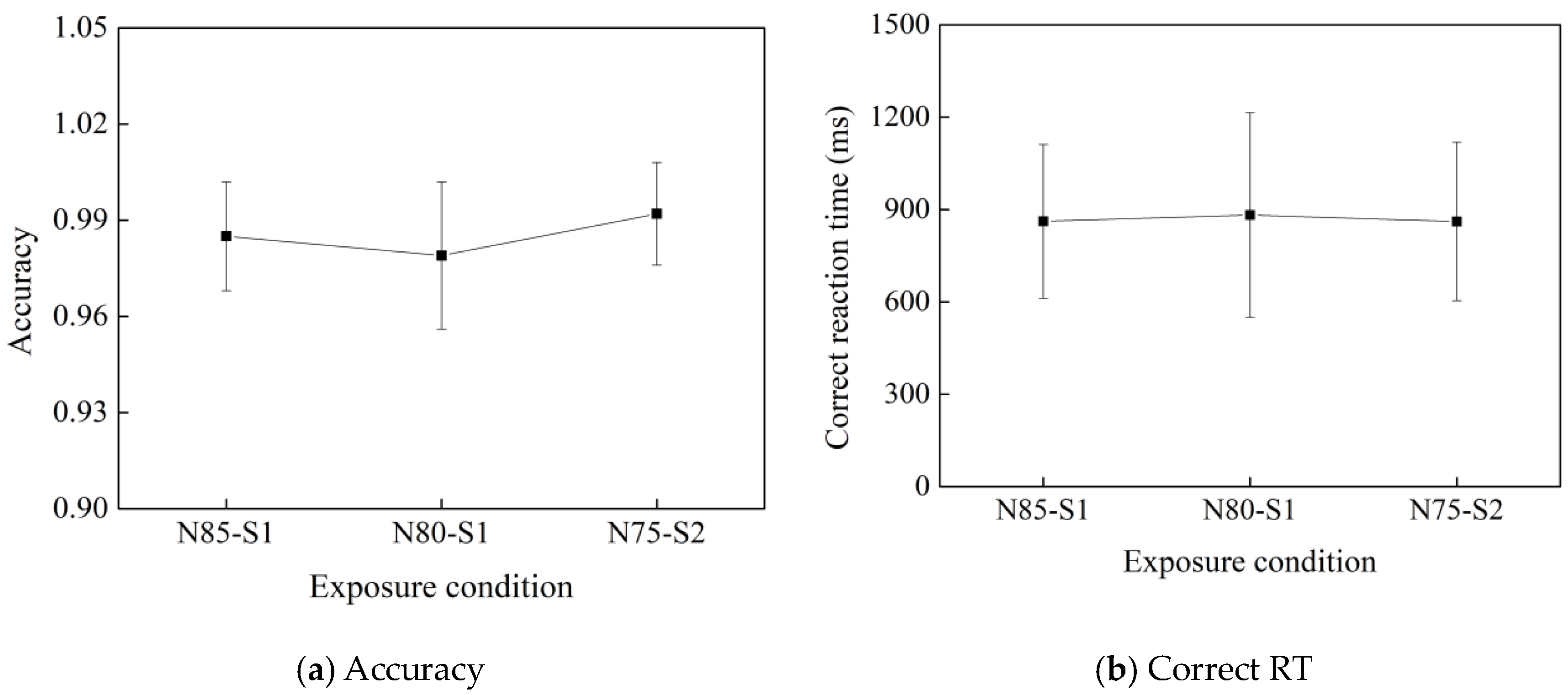

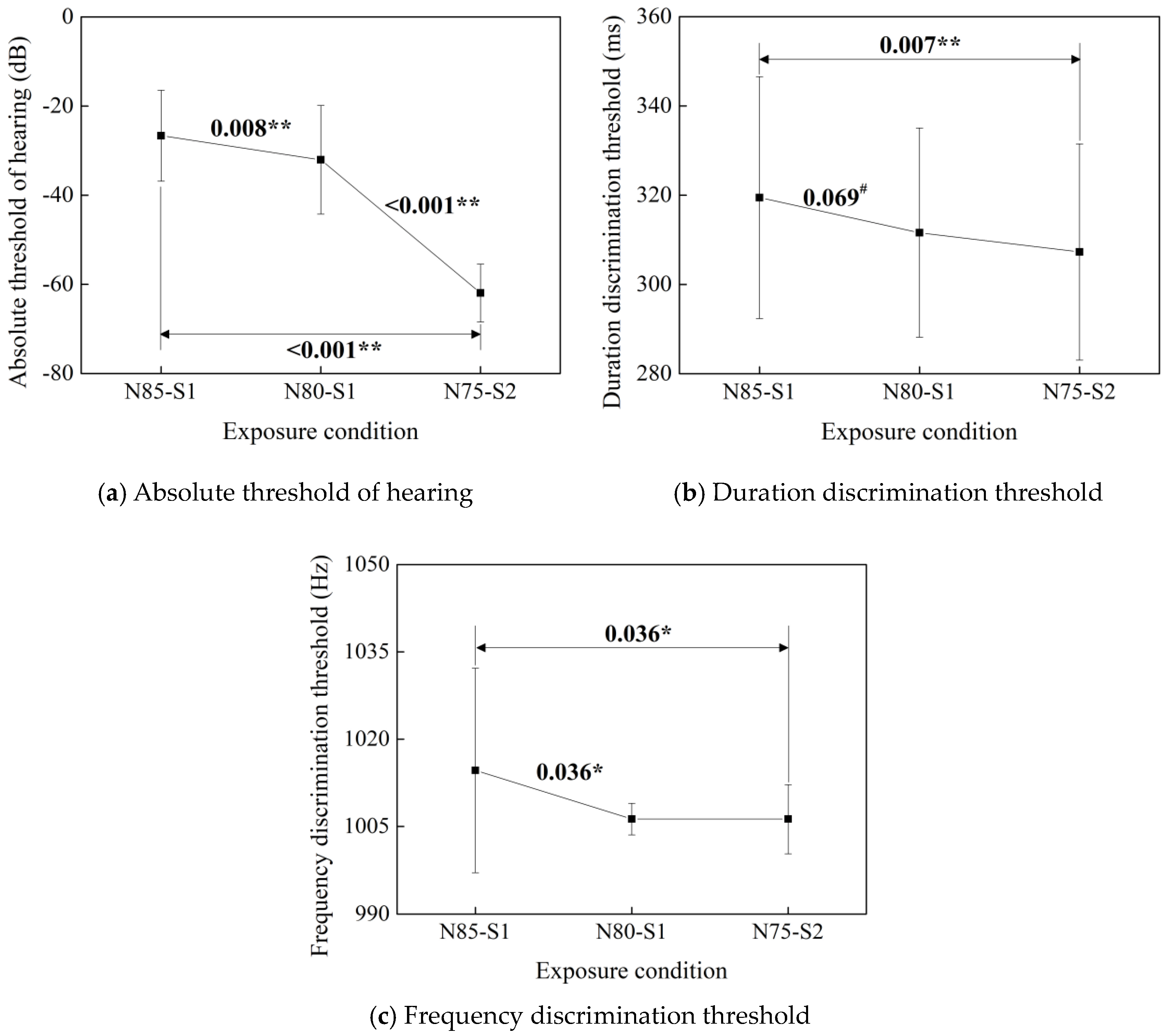
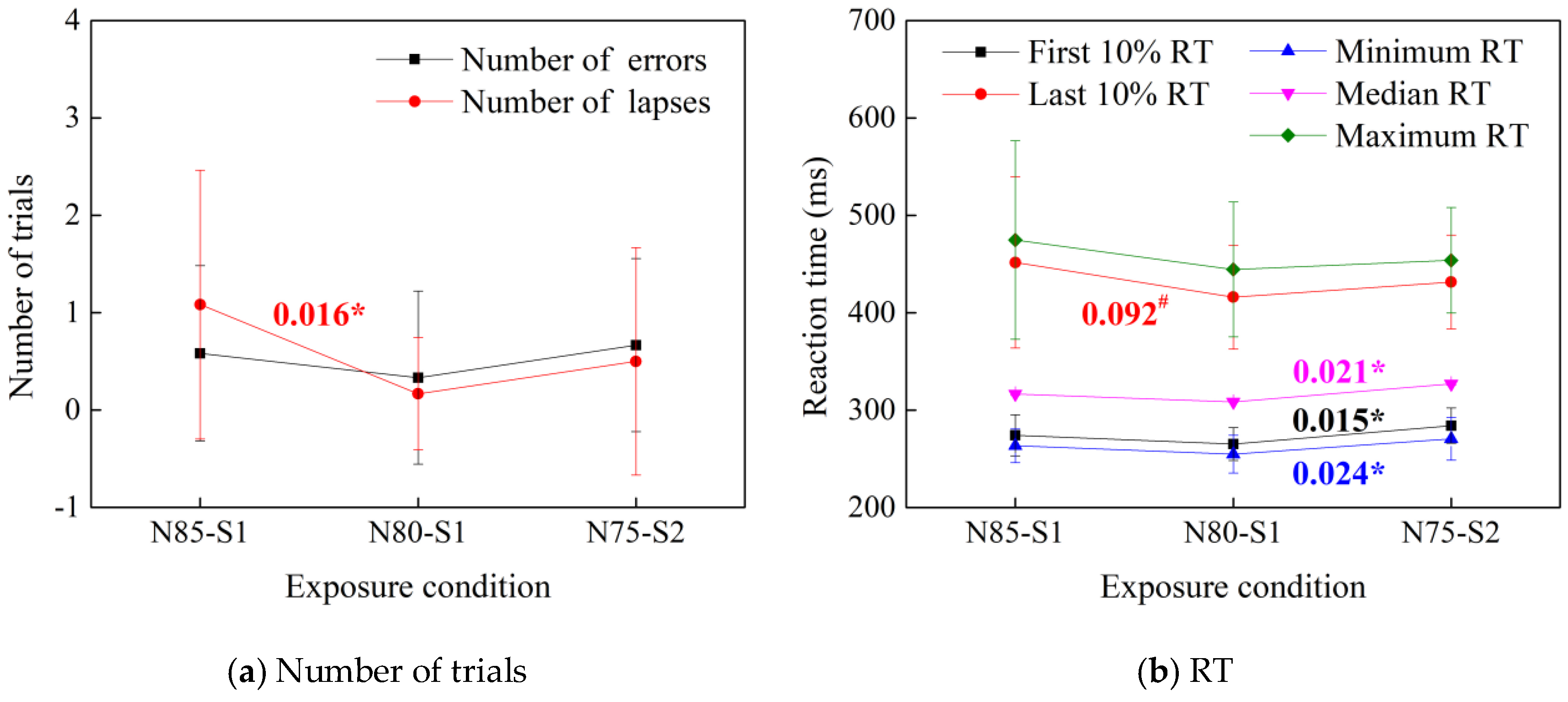

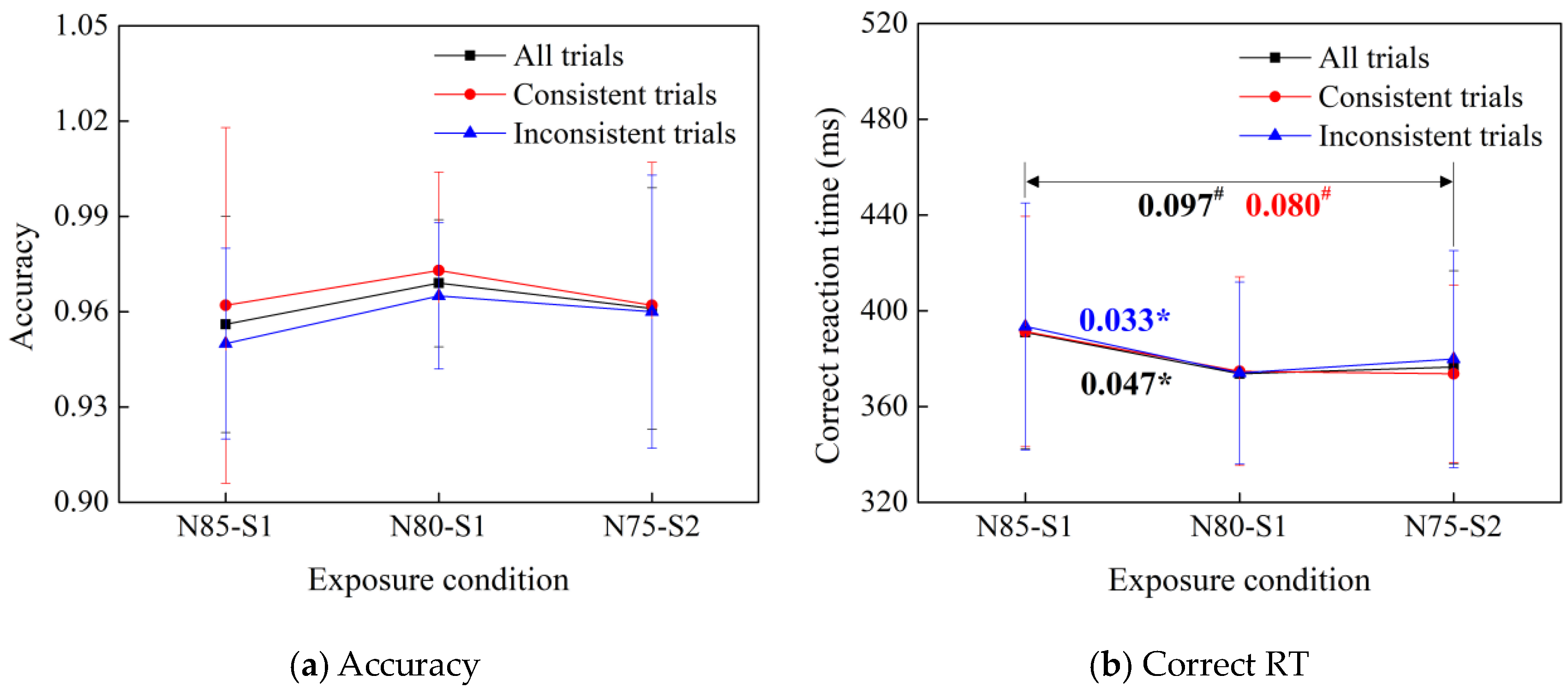
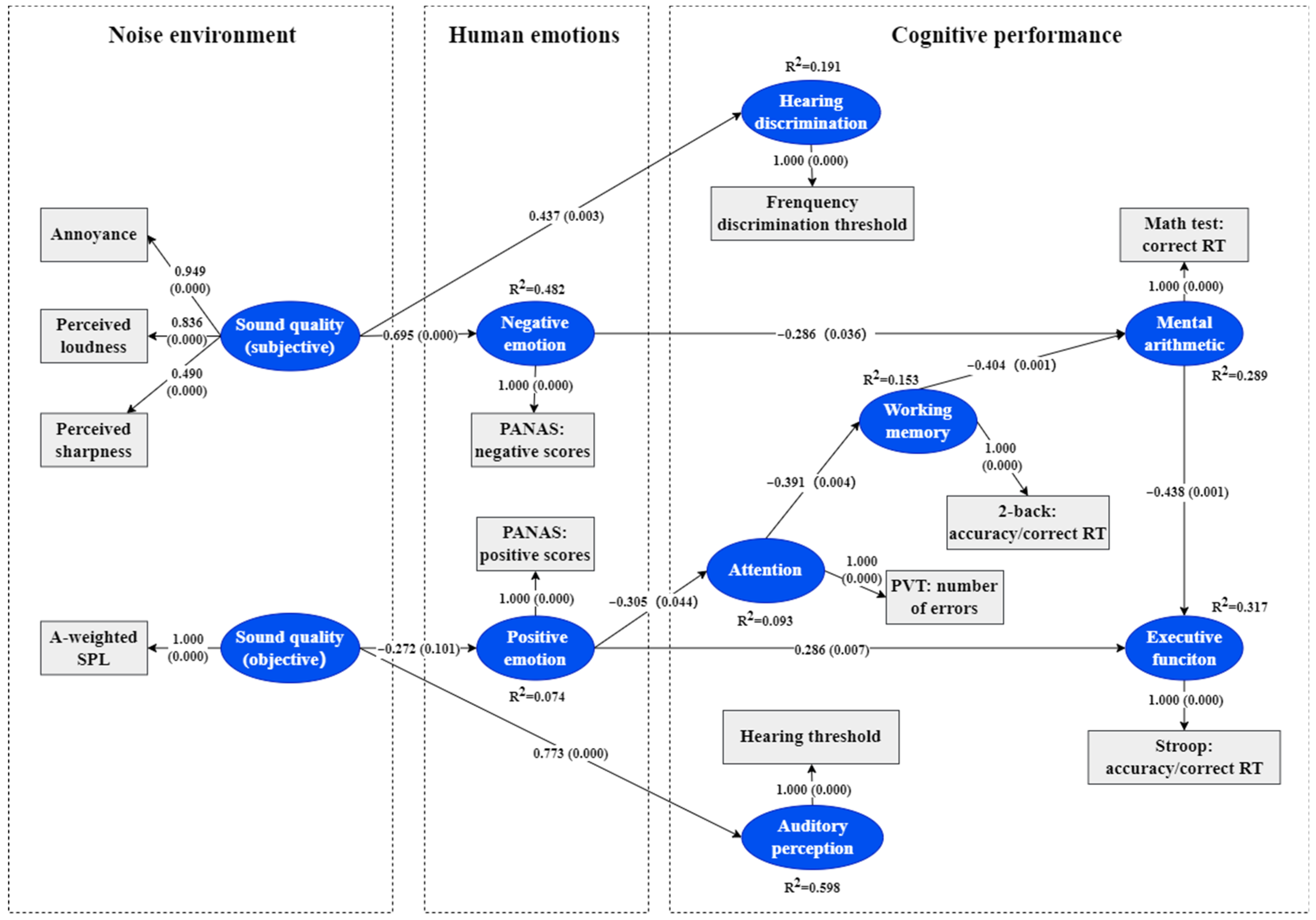
| Parameters | N85-S1 | N80-S1 | N75-S2 | N85-S1 | N80-S1 | N75-S2 | N85-S1 | |
|---|---|---|---|---|---|---|---|---|
| Acoustic environment | A-weighted SPL (dBA) | 84.235 ± 0.788 | 78.310 ± 0.729 | 74.960 ± 0.809 | 84.235 ± 0.788 | 78.310 ± 0.729 | 74.960 ± 0.809 | 84.235 ± 0.788 |
| Sharpness (acum) | 1.281 ± 0.028 | 1.297 ± 0.027 | 2.418 ± 0.036 | 1.281 ± 0.028 | 1.297 ± 0.027 | 2.418 ± 0.036 | 1.281 ± 0.028 | |
| Thermal environment | Air temperature (°C) | 20.862 ± 0.628 | 21.042 ± 0.641 | 21.077 ± 0.572 | 20.862 ± 0.628 | 21.042 ± 0.641 | 21.077 ± 0.572 | 20.862 ± 0.628 |
| Relative humidity (%) | 26.483 ± 8.143 | 28.957 ± 7.507 | 24.702 ± 5.354 | 26.483 ± 8.143 | 28.957 ± 7.507 | 24.702 ± 5.354 | 26.483 ± 8.143 | |
| Air velocity (m/s) | 0.123 ± 0.005 | 0.126 ± 0.010 | 0.123 ± 0.005 | 0.123 ± 0.005 | 0.126 ± 0.010 | 0.123 ± 0.005 | 0.123 ± 0.005 | |
| Black global temperature (°C) | 21.085 ± 0.567 | 21.243 ± 0.608 | 21.332 ± 0.475 | 21.085 ± 0.567 | 21.243 ± 0.608 | 21.332 ± 0.475 | 21.085 ± 0.567 | |
| Thermal sensation vote | −0.367 ± 0.863 | −0.350 ± 0.820 | −0.271 ± 0.827 | −0.367 ± 0.863 | −0.350 ± 0.820 | −0.271 ± 0.827 | −0.367 ± 0.863 | |
| Cognitive Ability | Test | Performance Metric (Unit) |
|---|---|---|
| Perception | Hearing threshold test Duration discrimination test Frequency discrimination test | Hearing threshold (dB) Duration discrimination threshold (ms) Frequency discrimination threshold (Hz) |
| Attention | PVT test | First 10% RT (ms) Last 10% RT (ms) Minimum RT (ms) Median RT (ms) Maximum RT (ms) Number of errors Number of lapses Reaction speed (1/s) Index of PVT (1/s) |
| Working memory | 2-back test | Accuracy (%) Correct RT (ms) |
| Mental arithmetic | Mental arithmetic test | Accuracy (%) Correct RT (ms) |
| Executive function | Stroop test | Accuracy (%) Correct RT (ms) Accuracy of consistent trials (%) Correct RT of consistent trials (ms) Accuracy of inconsistent trials (%) Correct RT of inconsistent trials (ms) |
Disclaimer/Publisher’s Note: The statements, opinions and data contained in all publications are solely those of the individual author(s) and contributor(s) and not of MDPI and/or the editor(s). MDPI and/or the editor(s) disclaim responsibility for any injury to people or property resulting from any ideas, methods, instructions or products referred to in the content. |
© 2024 by the authors. Licensee MDPI, Basel, Switzerland. This article is an open access article distributed under the terms and conditions of the Creative Commons Attribution (CC BY) license (https://creativecommons.org/licenses/by/4.0/).
Share and Cite
Zhang, J.; Pang, L.; Yang, C.; Fan, Y.; Zhao, B.; Cao, X. Experimental Evaluation of Noise Exposure Effects on Subjective Perceptions and Cognitive Performance. Buildings 2024, 14, 1100. https://doi.org/10.3390/buildings14041100
Zhang J, Pang L, Yang C, Fan Y, Zhao B, Cao X. Experimental Evaluation of Noise Exposure Effects on Subjective Perceptions and Cognitive Performance. Buildings. 2024; 14(4):1100. https://doi.org/10.3390/buildings14041100
Chicago/Turabian StyleZhang, Jie, Liping Pang, Chenyuan Yang, Yurong Fan, Bingxu Zhao, and Xiaodong Cao. 2024. "Experimental Evaluation of Noise Exposure Effects on Subjective Perceptions and Cognitive Performance" Buildings 14, no. 4: 1100. https://doi.org/10.3390/buildings14041100






